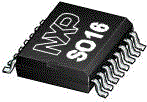Design Files
Receive the full breakdown. See the product footprint and more in the eCad file.
The TJF1052i is a high-speed CAN transceiver that provides a galvanically isolated interface between a Controller Area Network (CAN) protocol controller and the physical two-wire CAN bus. The TJF1052i is specifically targeted at industrial applications, where galvanic isolation barriers are needed between the high- and low-voltage parts.
Safety: Isolation is required for safety reasons, eg. to protect humans from electric shock or to prevent the electronics being damaged by high voltages.
Signal integrity: The isolator uses proprietary capacitive isolation technology to transmit and receive CAN signals. This technology enables more reliable data communications in noisy environments, such as electric pumps, elevators or industrial equipment.
Performance: The transceiver is designed for high-speed CAN applications, supplying the differential transmit and receive capability to a CAN protocol controller in a microcontroller. Integrating the galvanic isolation along with the transceiver in the TJF1052i removes the need for stand-alone isolation. It also improves reliability and system performance parameters such as loop delay.
The TJF1052i belongs to the third generation of high-speed CAN transceivers from NXP Semiconductors, offering significant improvements over first- and second-generation devices. It offers improved ElectroMagnetic Compatibility (EMC) and ElectroStatic Discharge (ESD) performance, and also features ideal passive behavior to the CAN bus when the transceiver supply voltage is off.
The TJF1052i implements the CAN physical layer as defined in the current ISO11898 standard (ISO11898-2:2003). Pending the release of the updated version of ISO11898-2:2016 including CAN FD and SAE J2284-4/5, additional timing parameters defining loop delay symmetry are specified. This implementation enables reliable communication in the CAN FD fast phase at data rates up to 5 Mbit/s.
The TJF1052i is an excellent choice for all types of industrial CAN networks where isolation is required for safety reasons or to enhance signal integrity in noisy environments.

|
|
|
|
|
|
|
|---|---|---|---|---|---|
|
|
|
|
|
|
|
|
|
|
|
|
|
|
|
|
|
|
|
|
|
|
|
|
|
|
|
|
|
|
|
|
|
|
|
|
|
|
|
|
|
|
|
|
|
|
|
|
|
|
|
|
|
|
|
|
|
|
|
|
|
|
|
|
|
|
|
|
|
|
Quick reference to our documentation types.
1-5 of 6 documents
Please wait while your secure files are loading.
Receive the full breakdown. See the product footprint and more in the eCad file.

Receive the full breakdown. See the product footprint and more in the eCad file.
Quick reference to our software types.
1 software offerings

Please wait while your secure files are loading.
1 software offerings

To find additional partner offerings that support this product, visit our Partner Marketplace.
2 engineering services


There are no results for this selection.
To find additional partner offerings that support this product, visit our Partner Marketplace.